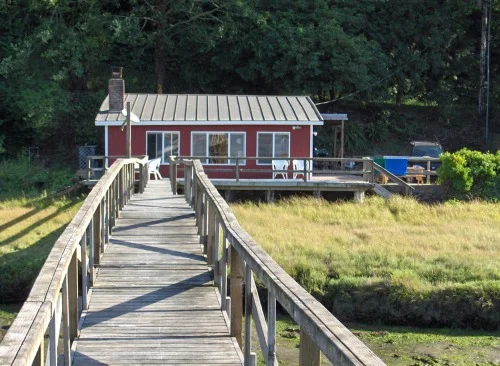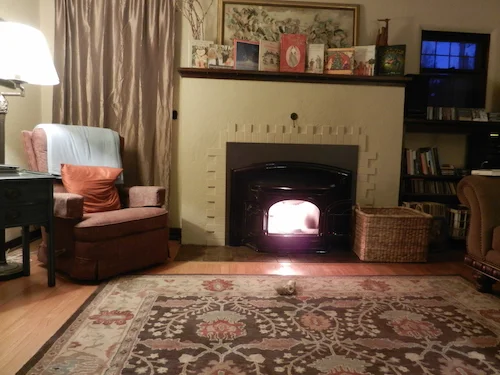Summer Lake

Photograph by Thomas Van Denend
I go and lie down where the wood drake
rests in his beauty on the water, and the great heron feeds.
—Wendell Berry, “The Peace of Wild Things”
The approach to Summer Lake on Hwy. 31 in south central Oregon feels a bit like you’re entering a Hollywood movie set for a modern-day Western. They call this part of the state Oregon’s Outback, and local names have a distinct pioneer charm. You can camp at Coffee Pot Flats, for instance, or have your supper at the Dinner Bell Diner. The actual “town” of Summer Lake boasts one gas station/general store, one small white community church, a handful of houses, the Department of Fish and Wildlife station, and a former Army barracks turned resort. No stoplights needed here because you’re in and out of town in less than a minute. But treasures await those willing to stick around.
A side street with the idyllic name, Thousand Springs Lane, hints at the storehouse of beauty surrounding you. Stands of billowy cottonwoods skirt the highway, a 7000’volcanic ridge covered in pine forest rises on your right, and a dramatic sweep of sky covers an enormous shallow lake like an overturned bowl of robin’s egg blue. People show up here for all kinds of reasons. Scientists study layers of lava flow that mark geologic time in this high desert basin, fisherman follow the abundant trout streams, retirees take the road less traveled on their way to California. And then there are folks like us. That huge body of wetlands draws us this Memorial Day weekend in late May. We have come for the birds.
Hundreds of species congregate in this inland marsh to rest and refuel on their way to and from Alaska and Central America. Thousands of shorebirds breed here every spring. Bird names fall from the lips like one-word prayers: avocet, ibis, bufflehead, phalarope, willet, shrike. If you come in mid-March, the locals tell us, you will witness a sight (and sound) that is something to behold, the migration of tens of thousands of snow geese. Sadly, there is always the unfortunate misfit who didn’t get the message. One solitary snow goose sat in the middle of the marsh on our visit looking utterly lost and forlorn. His tribe had moved on without him, his fate remained uncertain.
I joke that I married the original Boy Scout. In addition to his tying complex knots and making a great campfire quicker than anyone I know, my husband is a skilled birder. Though he grew up in what is now clearly urban sprawl, Northern New Jersey, he once scouted the woods and marshes of his native state — binoculars, field guide, and notepad in tow — at sixteen. I, on the other hand, only admired birds from afar, growing up as I did in many states with my nose usually deep in a book. And while I remember marveling at paintings by John James Audubon in the pages of National Geographic, I learned only the names of common backyard birds we all encounter, nothing more. Until now.
Our first morning out in the marsh brings unexpected delights. We run into a trio of birders from Terrebonne, a couple hours north. Two are retired biology teachers, one of whom has been coming to this lake for twenty-five years. They are serious about their pastime, judging by the gear they sport, but also quite friendly. They alert us to an old barn far out in the middle of the marsh where a pair of fledgling great-horned owls perch together on top of the roof. From a distance they look like two large, fluffy gray kittens huddled side by side for comfort. They are absolutely adorable. And they watch our every move with impossible 180-degree head turns. Swallows flit in and out of the eaves bringing more mud to patch their fragile, powdery homes. One of the many things I learn is that the average swallow weighs all of 2 oz. Good thing, or their tiny houses would collapse. Big Mama owl, wary of the attention we’re paying to her babies, keeps a close eye on us from inside the barn.
I come into the peace of wild things,
who do not tax their lives with forethought
of grief. I come into the presence of still water.
—Wendell Berry, “The Peace of Wild Things”
Summer Lake Wildlife Refuge was created in 1944 and is still managed by the state as both a refuge and a reserve for duck hunting, rather a unique example of cooperation between groups who often fight turf battles over environmental and recreational rights. The lake is what’s known as a hemi-marsh, meaning 50% water and 50% vegetation. Eight miles of winding gravel road loops through the marsh, plus long walking dykes and several small foot bridges that span the canals and inner pools. Huge underground springs feed the lake from snow runoff cascading down Winter Ridge.
Each day as we drove our little Honda very gingerly into the marsh, we would park and then walk, or set up the spotting scope to zero in on a pair of trumpeter swans hiding by the banks or a yellow-headed black bird singing his heart out on a cattail. Sunday morning we made it out there just after the sun had risen and noticed an elegant Sandhill crane standing alone in the middle of the road, backlit by the sun’s glow. If the “early bird gets the worm”is a truism, then a corollary would be this: the early birder gets the bird. A pair of good binoculars and trusted field guides are travel essentials in this pristine aviary. We brought two: the classic Peterson’s Field Guide, which shows all the sub-species of each bird under the same heading, and Stokes Field Guide to Western Birds, with its pages of full-color photographs (most helpful for identification purposes, because you can’t list it if you really don’t know what it is!)
The weekend before Summer Lake, I was up in Seattle visiting my oldest sister and enjoying a solo literary getaway, attending a wonderful reading and reception for poet Scott Cairns, sponsored by Image. I wore my favorite little black dress and new snappy green sandals. While there, I ate in two fashionable restaurants, and I rode the Amtrak Cascades coming and going. I thoroughly enjoyed my Big City romp, living as I do in a small, quaint college town of 55,000. But Summer Lake offers me something neither of those places ever can — the expanse of wilderness. Every day we surround ourselves with manmade structures and agendas and priorities set by us, the human beings. When you venture into those wetlands you are reminded again that an entire world happens out there without you, every day, every season of the year. Staggering, beautiful, abundant life. The peace of wild things.
One of the short videos my husband took at Summer Lake has no narration to it. It’s simply the common sounds of the marsh: the raucous ducks, the ratchety marsh wrens, the plaintive cranes, the whistling terns, the shrill hawks, and the softly hooting doves. I would’ve been content to pull up a camp chair and just listen for an hour, thermos of coffee in hand. I wasn’t really looking for another hobby, but it seems I’ve found a compatible one in birding. We recorded eighty-one species in two and a half days. Not bad for an occasional birder and wannabe sidekick. Hang around with some veteran birders and you’ll soon learn their secrets. I have a long way to go to catch up with my husband, but I can tell the difference (without binoculars) between a red-tail hawk soaring high overhead and a turkey vulture, just by the shape of their wings and how they fly. I now recognize a Lazuli Bunting from a Western bluebird, even though they both have blue coats and reddish breasts. I know a crow’s tail is flat and a raven’s is shaped more like a spoon. Ravens are larger, and crows are their archrivals.
For a time
I rest in the grace of the world,
and am free.
—Wendell Berry, “The Peace of Wild Things”
Another little known secret to share: when my husband and I take these wilderness trips together we don’t bicker and nitpick like we often do at home. We’re less grumpy, more genial. Everything slows down; we are not the center of the universe. Our homegrown cares diminish in significance and our impatience with one another’s quirks, well-noted after long years of marriage, slough off. We’re already planning our next trip for the end of September. Fall migration in full display. No duck hunters yet, not until October. Maybe we’ll camp this time and wake to savannah sparrows just outside our tent flaps. Maybe we’ll make our goal of 100 species, not that anyone else takes note. It’s as if we, too, by returning to a simpler, gentler habitat, transform into another species. Not forever, but for a time, as the poet puts it, we rest in the grace of the world.
Please read a note from the Art House America Board about the future of the blog.


















